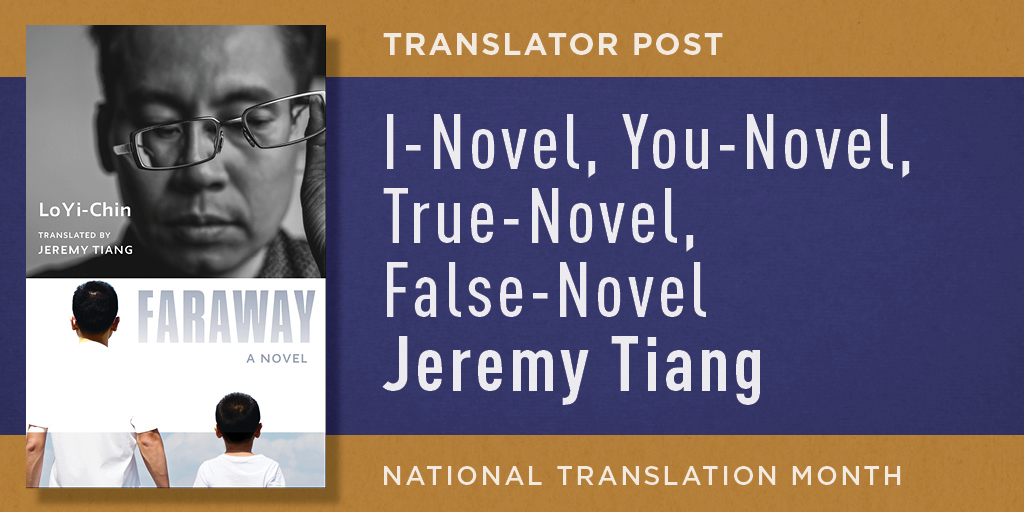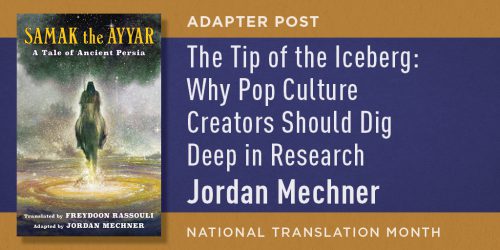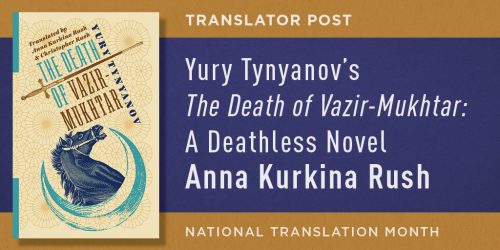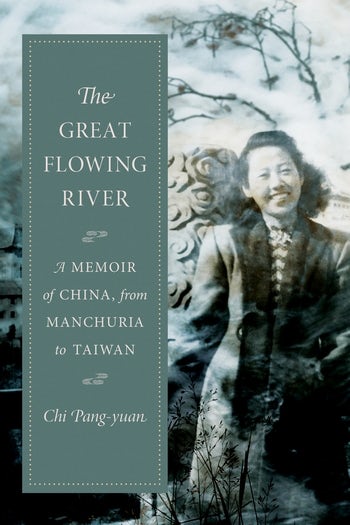I-Novel, You-Novel, True-Novel, False-Novel
By Jeremy Tiang

“Compared to the world of novels—of the imagination—the real world was a letdown.”
~Minae Mizumura, Inheritance from Mother (tr. Juliet Winters Carpenter)
Lo Yi-Chin’s Faraway tells the story of a man named Lo Yi-Chin, also a Taiwanese novelist, who embarks on a frantic journey to mainland China after his father, there for a visit, succumbs to a brain hemorrhage and ends up comatose in hospital. Meanwhile, back in Taiwan, Lo’s wife is heavily pregnant. After a lengthy ordeal involving a series of mishaps with Chinese bureaucracy and misunderstandings with family, Lo manages to have his father repatriated to Taiwan, arriving in time for his son’s birth.
All these events actually did happen to Lo Yi-Chin, albeit not exactly as described in the book. When I first met Lo to discuss translating his work, he said I should treat it as fiction and that its contents were approximately “90 percent true.” Thinking of the moment in Faraway when “Lo Yi-Chin” assaults a small child as revenge for his son getting bullied, I asked him which parts of the book were invented; he looked me in the eye and said, “I don’t really remember.”
This real-and-not-real, autobiographical-yet-not narrative may appear to slot into the Western genre of autofiction, currently enjoying a vogue thanks to the success of Ben Lerner, Karl Ove Knausgård, Sheila Heti, and other practitioners. In fact, Lo’s immediate antecedent is the shishosetsu, often translated as “I-novel,” a literary form that arose in Japan in the early twentieth century, described by Minae Mizumura thus: “In an ‘I-novel,’ readers expect the writer to figure in the work in one way or another. Whether the work is in fact based on the writer’s life or is a contrivance is ultimately irrelevant. The author-protagonist of an ‘I-novel’ is perceived as an actual, specific individual, one whose face may be publicly known in other media. The work is necessarily assumed to be truthful about that individual’s life.” Moreover, these books tend to be “fragmentary” and demonstrate “the absence of authorial will—of the intention to create, through words, an independent universe.” In other words, she scathingly concludes, it is “the facile passing off of a how-I-suffered story as literature.”
The harshness of this description is indicative of the low esteem with which shishosetsu are held in certain quarters of the Japanese literary establishment…
The harshness of this description is indicative of the low esteem with which shishosetsu are held in certain quarters of the Japanese literary establishment, but may also be taken with a grain of salt, given that it comes from A True Novel (2002, tr. 2013 by Juliet Winters Carpenter), and refers to Mizumura’s previous work of fiction, An I-Novel (1995, tr. 2021 by Juliet Winters Carpenter). A True Novel also contains an autofictional frame, in which the Mizumura character mentions the doubts that assailed her (or at least, this fictional version of her) in composing her previous book: “By bringing out these memories in the form of a novel I felt I could atone for all the time that had passed, time that weighed on me. I just didn’t know why I had such difficulty writing it. Was it because I felt uneasy writing about my life in such an unmediated way, uneasy writing in the ‘I-novel’ tradition of Japanese literature, where the author is too readily forgiven for—no, indulged; no, not only indulged, actually encouraged in—wallowing in his own life?”
Kenzaburō Ōe recalls, in “An Attempt at Self-Discovery in the Mythic Universe of the Novel” (World Literature Today, Winter 2002), that having written A Personal Matter “to reconfirm the meaning of my response and the meaning of the action I had taken” after his son was born with a cranial deformity, he then worried that a book that drew so much on his personal life would be regarded by readers as an I-novel, “a genre customarily relegated to a low position in the Japanese literary world” and one that Ōe believed to have an “imagination-restricting taboo.” He resolved this by seeking “to enter into a new contract with my readers,” assuring them that they were not about to read an I-novel, yet “to continue saying to my readers that the themes of my novels and stories were rooted in my actual life.” Speaking to The Paris Review in 2007, Oe expanded on the restrictions of this form: “The I-novel is about what happens when the everyday life of the author is interrupted by an unusual or special event—a tsunami, an earthquake, the death of a mother, the death of a husband. It never opens up to a question about the individual’s role in society” (interview by Sarah Fay, tr. Shion Kono).
Although Lo’s work is often placed in this genre, given the confessional nature of many of his books, he has pushed back against this perception in a similar vein. When asked in a 2013 interview about being considered an I-novel writer, Lo replied, “Actually, that’s a ruse. When I was younger, I liked Japanese novelists, and was particularly influenced by Kenzaburō Ōe. Japan has a shishosetsu tradition, but Ōe wrote against this genre, creating a sort of fake I-novel. I did the same, adding in a lot of details that appeared to be about me but that couldn’t possibly have happened in the real world. Or I wrote about things that actually had happened, but ‘bragged’ about them until they were completely exaggerated and fantastical.”
Although Lo’s work is often placed in this genre, given the confessional nature of many of his books, he has pushed back against this perception in a similar vein.
Lo’s recent books have pushed this further, into more fantastical territory. Daughter (Nu Er, 2014) appears to be yet another Lo Yi-Chin I-novel, about the author’s difficult relationship with his adult daughter, who lurches from crisis to crisis as he watches haplessly. The only thing is—as we know from his previous I-novels—Lo doesn’t actually have a daughter, only two sons. And indeed, he confesses a few chapters in, “I’m not sure when I first had the idea of fabricating a daughter out of thin air, but the notion clung persistently to me, like a masterpiece surrounded by layer after layer of barriers, surveillance cameras, and security guards, that the museum had declared to be impossible to steal.” After all, if one is to self-fabulize, who is to say where the limits to invention lie? In his latest novel, Ming Dynasty (Ming Chao, 2019), the Lo character shares his annoyance that because he is known as an I-novel writer, readers often assume everything in his work is autobiographical—hence, perhaps, the temptation to sow outright falsehoods to mislead the unwary.
His own life is not the only one that Lo mines for his truth-blurring work. At an event in mainland China a decade ago, the author Zhang Yueran warned the audience not to tell Lo any stories they wished to keep for themselves. “He excels at making other people’s stories his own. There is no boundary between his self and other people,” she warned—not that this is necessarily a bad thing. “Any writer would envy someone like him, so deficient in experience himself, yet able to produce such rich work.”
And indeed, in Dispatch of Grief (Qian Bei Huai, 2001), his elegy of sorts to the late Qiu Miaojin, Lo refers to “former acquaintances I put into my books, not even changing their names, and inserted into exaggerated, awkward situations: an elementary school classmate, my first love, my chief counsellor in the army, the owner of a beancurd shop in a nearby alleyway. … At some point we’d run into each other again, and they’d scold me, blushing but also a little proud, ‘I saw your piece in the newspaper, and hey—why did you write that about me?’ or ‘It wasn’t like that at all, here’s what actually happened…’”
At an event in mainland China a decade ago, the author Zhang Yueran warned the audience not to tell Lo any stories they wished to keep for themselves.
Who can claim ownership over a story? Lo’s free borrowing has led to accusations of appropriation and even plagiarism, although he is clear that he works through a process of collage, and everything he takes in this way is filtered through his own sensibility and voice. He acquires narratives, not words. Of course, it’s understandable that people might object to having their lives used like this—in the New Yorker, Katy Waldman describes her shock and outrage at finding a novelist had based a storyline on a personal essay Waldman had written about her sister, transforming her “from a superpowered narrator back into a character, like a blue fairy downgrading the real, live boy,” or in other words, taking away her agency. And yet, is not all fiction a borrowing of one sort or another?
Jean Hanff Korelitz’s The Plot features a washed-up novelist turning his life around by repurposing the story told to him by a now-dead writing student into a bestseller. He justifies himself: “In my world, the migration of a story is something we recognize, and we respect. Works of art can overlap, or they can sort of chime with one another. Right now, with some of the anxieties we have around appropriation, it’s become downright combustible, but I’ve always thought there was a kind of beauty to it, the way narratives get told and retold. It’s how stories survive through the ages.” This does not qualify as plagiarism, he insists, only perhaps the theft of a story, “like how Jane Smiley stole A Thousand Acres from Shakespeare or Charles Frazier stole Cold Mountain from Homer.” It is simply building on what has come before, as all authors do, writing in conversation with our literary ancestors.
The Mizumura character in A True Novel tells us how “out of the blue, I was made a gift of a story, ‘a story just like a novel.’ What is more, the story was meant for me alone.” This ostensibly refers to the tale told to the narrator by Yusuke Kato, though of course the story Mizumura actually draws from is Emily Brontë’s Wuthering Heights, with Kato himself standing for Mr. Lockwood. Elsewhere in the book, Mizumura refers to how Takeo Arishima “reworked Tolstoy’s Anna Karenina in a Japanese setting” in Aru Onna (1919, tr. as A Certain Woman by Kenneth Strong, 1978), just as Mizumura relocates Brontë’s novel, so steeped in its setting of the Yorkshire moors, to postwar Japan
He reaches into his own life and the lives of others to create his fictions, while his writing in turn helps him make sense of the world and his place in it.
It is possible that for Mizumura, this appropriation is a way of bridging the gaps within herself, an author who writes in Japanese despite having spent her formative teenage years and early adulthood in the United States. In An I-Novel, Mizumura’s sister says to her, “What could you possibly write about if you were going to write in Japanese? I mean, you haven’t lived in Japan for eons.” Turning the question on its head, Mizumura explores this conundrum through her work, disposing of the difficulty by treating it as fuel for her writing rather than an obstacle.
For Lo, the traffic seems to go in both directions. He reaches into his own life and the lives of others to create his fictions, while his writing in turn helps him make sense of the world and his place in it. In Faraway, he says of the experience he is describing, “This is practically a fable. My father, in a vast and unfamiliar country, collapsing in what looked like sudden death, then my mother and I making our ramshackle journey of a thousand miles to rescue him. How could I recollect such a trip as merely a record of travel?”
In other words, how can the immensity of major events in our lives be reduced to mere facts, dates, and destinations? At least one of the I-novelist’s motivations, surely, is to use the artifice of fiction to digest raw experience, and to place a frame around a segment of life in order to make sense of it. With Faraway, Lo processes his grief at his father’s illness and death, as well as the emotions dredged up by this painful time. Almost twenty years on, this multifaceted book is finally being published in English, and I like to think of the translation process as another lens through which this narrative can be viewed, a further layer of artistry being laid over the substance from which the book was crafted, life itself.
Jeremy Tiang has translated works by writers including Yeng Pway Ngon, Su Wei-Chen, Yan Ge, Zhang Yueran, Chan Ho-Kei, and Li Er. He is the translator of Faraway: A Novel, by Lo Yi-Chin.








